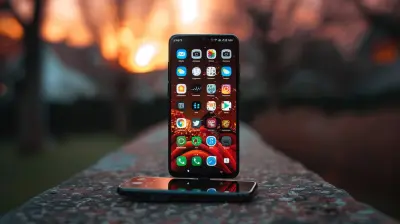Understanding the Advantages of Dart for Mobile App Development
28 October 2025
Let’s be real—mobile app development is evolving at a wild pace. Every few months, new tools and frameworks are popping up, promising faster development, smoother performance, and fewer headaches. But there’s one programming language that has quietly been making serious waves, especially in combination with Flutter. Yep, I'm talking about Dart.
If you’ve been wondering whether Dart is worth your attention or just another overhyped language, you’re in the right place. In this article, we’ll break down the real advantages of Dart for mobile app development in a chill, conversational way—no buzzwords, no fluff, just real talk.

What is Dart, Anyway?
Before we dive deep into the benefits, let’s hit the basics. Dart is an open-source, general-purpose programming language developed by Google. It’s primarily used for building mobile, desktop, server, and web applications. But where Dart really shines is when it’s paired with Flutter, Google’s UI toolkit for building natively compiled applications for mobile, web, and desktop from a single codebase.Think of Dart and Flutter as Batman and Robin—individually strong, but together? Absolute game-changers.

Why Dart Is Gaining Popularity
You might be wondering, “We already have Java, Kotlin, Swift, and other all-stars, so why bother with Dart?” Great question. Here’s the thing—Dart is solving a lot of the pain points developers face with those traditional languages. It’s not just about writing code, it’s about writing better, faster, cleaner code, and doing more with less.Let’s get into the juicy advantages.
1. Single Codebase for Both iOS and Android
This one’s a game-changer. Dart enables you to write one codebase that runs on both iOS and Android. No more switching between Swift for iOS and Kotlin for Android.Imagine you're a developer juggling two versions of the same app for two platforms. It’s like being asked to make two different kinds of sandwiches for every order. With Dart and Flutter, you make just one killer sandwich—and it works for everyone. That saves time, reduces bugs, and simplifies testing.
Why It Matters:
- Faster time-to-market- Reduced development costs
- Easier cross-platform management

2. Hot Reload = Instant Gratification
Let’s talk about one of Dart’s most delightful features when used with Flutter: Hot Reload.Ever made a change in your code and then waited for what felt like an eternity for it to compile, run, and show up on the emulator? Yeah, we’ve all been there. With Dart and Flutter’s hot reload, changes appear instantly, without restarting the entire app.
It’s like updating your Instagram bio and seeing the change immediately—no refresh required.
Why It Matters:
- Speeds up development exponentially- Encourages experimentation and creativity
- Super helpful for debugging UI glitches
3. Performance Close to Native
Now, let’s talk performance. Dart compiles directly to native code. This means apps built with Dart aren’t bogged down by bridges or interpreters like some cross-platform frameworks.The result? Lightning-fast performance that can actually rival native apps built with Java or Swift. We’re talking smooth animations, quick load times, and seamless transitions.
Why It Matters:
- Better user experience- Competitive edge in a crowded app market
- No trade-offs between cross-platform and native feel
4. A Rich Set of Libraries and Tools
Dart comes with a powerful standard library that has all the essentials for mobile app development, from HTTP requests to file manipulation and more. Plus, there’s a growing ecosystem of community-created packages that are just a few lines of code away.Need a package for Firebase integration? Navigation? State management? There’s (probably) a Dart package for that.
It’s like having a toolbox where every tool actually does its job—and you don’t have to dig through cobwebs to find it.
Why It Matters:
- Saves developers tons of time- Improves code maintainability
- Reduces dependency on external SDKs
5. Clean and Understandable Syntax
Let’s admit it—some languages feel like they were designed to confuse you. Dart isn’t one of them. Its syntax is clean, modern, and super easy to pick up, especially if you’ve used JavaScript, Java, or even C#.For new developers, Dart is like that friendly professor who makes complicated stuff sound simple. For seasoned devs, it’s refreshing—a reminder that coding doesn’t have to feel like deciphering ancient runes.
Why It Matters:
- Low learning curve- Easier onboarding for teams
- Code readability = fewer bugs
6. Strong Community and Backing by Google
You’re not going on this journey alone. Dart is backed by Google, which is investing heavily in its ecosystem. Plus, the developer community has grown significantly, especially with the popularity of Flutter.There are tons of tutorials, documentation, YouTube videos, and Stack Overflow threads. If you hit a wall, chances are someone else has too—and they’ve already found a way around it.
It’s like joining a giant group project where everyone’s trying to help you ace the grade.
Why It Matters:
- More learning resources- Frequent updates and bug fixes
- Reliable long-term support
7. Versatility Beyond Mobile
Even though we’re focusing on mobile here, it’s worth mentioning that Dart is incredibly versatile. You can use it to build web apps, desktop apps (Mac, Windows, Linux), and even backend services.So if you're someone who dreams big and wants an app that works everywhere? Dart has your back. It’s like buying a Swiss Army knife when everyone else is carrying just a butter knife.
Why It Matters:
- Reusable code across platforms- Scalable for future projects
- Less context switching for full-stack devs
8. Great for MVPs and Startups
If you’re working in a startup environment or planning to launch a Minimum Viable Product (MVP), Dart and Flutter are fantastic choices. Why? Speed. Efficiency. Cost-effectiveness. You can get a sleek, fully functional app out the door faster than ever before.You don’t need a huge team—one or two devs can build a cross-platform app that looks and feels great. That’s a big deal when you're racing against time (and budget).
Why It Matters:
- Quicker validation of ideas- Ideal for rapid prototyping
- More bang for your buck
9. Consistent UI Across Devices
One of the things that makes Dart (via Flutter) stand out is widget-based architecture. Widgets are like little building blocks that you stack together to create your app. These widgets are rendered the same across platforms, meaning your UI looks consistent on both iOS and Android.You don’t have to worry about design weirdness or inconsistencies caused by system-level UI components. It’s like making sure your brand logo doesn’t mysteriously change color on different devices.
Why It Matters:
- Uniform user experience- Streamlined design-to-dev workflow
- Less time tweaking UI for different devices
10. Ease of Testing and Debugging
Testing isn’t the sexiest part of app development, but it’s one of the most important. Dart makes it painless with robust support for unit, widget, and integration testing.Plus, the hot reload feature makes debugging feel less like a chore and more like a real-time conversation with your app. You slap in a fix, and boom—it’s there, ready to test.
It’s like having autocorrect for your app code (minus the embarrassing autocorrect fails).
Why It Matters:
- Better app quality- Faster development cycles
- Happier users (and devs)
Final Thoughts: Is Dart Worth It?
So, is switching to Dart for your next mobile app project worth it? Here’s the honest answer—if you value speed, simplicity, performance, and the ability to build cross-platform apps without losing your mind, then yes, Dart is absolutely worth digging into.Sure, it may not have decades of widespread industry use like Java or Swift, but it's catching up fast—and with Google’s backing and Flutter’s steady rise, it’s becoming a top-tier choice for serious developers.
Dart isn’t just a trend. It’s a legitimate tool that can make your mobile app development journey smoother, faster, and dare we say… fun.
Give it a shot. You might just fall in love.
all images in this post were generated using AI tools
Category:
Coding LanguagesAuthor:

Vincent Hubbard
Discussion
rate this article
1 comments
Helen McNaughton
This article beautifully captures the essence of Dart and its benefits for mobile app development. It's refreshing to see such clarity in explaining how Dart's features enhance productivity and performance. As a developer, I appreciate insights that help us make informed decisions. Thank you for sharing this valuable information!
October 29, 2025 at 5:52 AM

Vincent Hubbard
Thank you for your kind words! I'm glad you found the article helpful in highlighting Dart's benefits for mobile app development. Your feedback is greatly appreciated!


